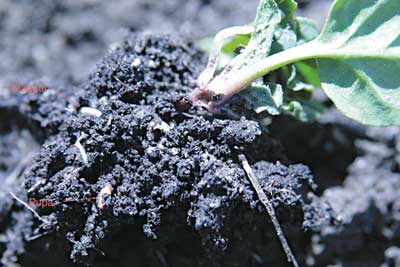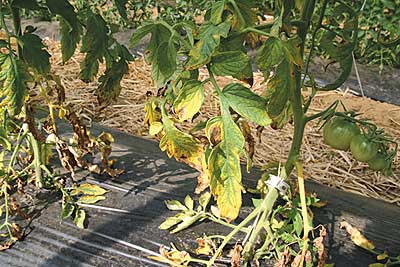 |
| Seedcorn maggots feeding on young spinach. |
 |
| Seedcorn maggots in soil amended with soy meal. |
 |
| European corn borer overwintering in a corn stalk. |
 |
| Early blight on lower leaves of tomatoes. |
 |
| Close-up of early blight on tomato. |
 |
| Late blight on potato. |
By Eric Sideman, Ph.D.
Fall garden care is the beginning of spring garden pest management. Many insects and pathogens spend the winter in the soil or on crop debris in wait for next season’s plantings. If such pests are recurring problems for you, then the best time to rid your garden of them is the fall. If these pests are not a problem for you, then I recommend the guiding principle of adding as much crop debris as possible to the soil in the fall. Below are some common gardening issues and some options for fall management.
Seedcorn Maggot
The seedcorn maggot is the larvae of a fly. This critter spends the winter as a pupa in the soil. Flies emerge very early in the spring from these pupae and lay eggs near decaying organic matter and germinating seeds. The eggs hatch into maggots that feed on the seeds or young plants. Gaps in rows of crops such as onions, spinach, corn, peas, etc., often blamed on poor seed, actually result more often from seedcorn maggot feeding. The fly is often attracted to decaying organic matter, including some fertilizers that organic farmers use, such as soybean meal. In such cases the maggots end up feeding on the seeds and seedlings.
Fall is the time to start thinking about managing this pest because the pupae that overwinter come from eggs laid in the fall. Row covers put on in the spring, just after seeding or transplanting, may keep new seedcorn maggot flies from coming into your field, but they won’t work if the pupae are already in the soil that you are covering. These flies will emerge under the cover and lay eggs that result in maggots happily feeding on your crops. To avoid this issue, avoid adding attractive organic matter (e.g., manure, lush cover crops, etc.) in the fall to soil in fields that you plan to use for early spring crops.
European Corn Borer
Everyone has found a “worm” in an ear of corn at some time. These are not actually worms but caterpillars. Three major caterpillar pests can feed on sweet corn. The corn earworm and the fall armyworm do not winter in northern New England, so fall management plays no role in controlling these two. These moths come up from the south riding on storms; some years they are plentiful, and other years few make it here. In contrast, the European corn borer (ECB) does overwinter here, and fall management is key to the level of damage to your corn.
The ECB feeds on many kinds of plants, but corn is among its favorites, and managing these caterpillars in corn makes a big difference in how many survive from year to year to become a problem. The ECB overwinters as full-grown larvae (caterpillars) in the stalks of corn crop debris on which they were feeding. They pupate in the spring, and the moths emerge and mate in grassy or weedy areas near the field border. Then the female moths fly around looking for a host plant on which to lay eggs – often your corn. They can feed on leaves, stalk and ears.
Most commonly, they overwinter in the bottom few inches of the corn stalk. At the end of the season, corn stalks should be chopped short and then the stubble should be tilled into the soil. This may not control the pest, however. If a neighboring dairy farmer leaves 6-inch-tall infested corn stubble after cutting silage corn, your efforts may do little. But if you are pretty isolated from other infested crops, how you manage your corn debris is the key to the level of next year’s problem.
Early Blight of Tomato
Early blight is caused by the fungus Alternaria solani. It is also common in potatoes, but rarely affects eggplant or peppers. This may be the most common cause of the death of tomato plants in late summer, although septoria leaf spot, which has a similar life history and management recommendation, may be just as common.
All of the above-ground parts of the plant may be infected by early blight. Most commonly, the lower leaves are infected first with spots that have concentric lines, similar to an oyster shell. The spots enlarge, the leaf turns yellow, and then it turns brown and dies. Weather determines how quickly the disease progresses up the plant and kills all the leaves. The longer the leaves are wet, the quicker the spread. The spores need a wet surface to germinate, so management during the growing season is based on keeping the leaves dry.
Management begins in the fall. The early blight pathogen overwinters on diseased plant residue. The first infection is usually caused by spores being splashed up from the soil onto the lower leaves of the tomato plant. Then the fungus grows on those leaves and releases more spores to be splashed higher and blown in the wind.
Getting rid of as much tomato debris in the fall as possible will go a long way to delaying the spread of the disease. Disinfecting stakes or cages will get rid of the tiny bits of diseased plants that can lead to new infection next spring. (Certified organic growers must be sure to use an approved disinfection product. Sodium hypochlorite at 0.5% is effective and must be followed by rinsing and proper disposal of the solution. Hydrogen peroxide is also effective.) This fall management will not solve the problem of early blight because by midsummer the air is full of spores blowing from infected plants all over the region. But efforts you make in the fall will delay infection in your garden, and at least you will not be the source of the initial infection.
Late Blight
Late blight, a destructive disease of potatoes and tomatoes caused by the fungus Phytophthera infestans, is pretty rare in southern Maine but is much more common in the potato growing regions of the state because the pathogen needs a living host to survive. For the most part, the only part of the tomato or potato plant that lives through winter in New England is the potato tuber if it is protected from freezing. In the potato growing regions of Maine, plenty of cull tubers are lying around and can serve as the source of spring infection. Late blight develops in New England either from potato tubers that have been protected from freezing by being buried deep enough in the soil or in a pile of cull potatoes, or by spores blowing in from away where the pathogen lived though the winter.
If late blight is an issue, be sure at the end of the season that all potato tubers are destroyed or are left on the surface of the ground to freeze during winter.
Many other gardening and farming problems can be fixed by good fall management. If some problem recurs year after year in your crops, read about the life history of the pest or pathogen and see if you can do something in the fall to break its cycle. A good source for this information is the “Resource Guide for Organic Insect and Disease Management” (second edition), available as a free PDF at https://web.pppmb.cals.cornell.edu/resourceguide/. You can also sign up for my Pest Reports or read them on MOFGA’s website. Click on “Pest Reports” under the Publications tab on www.mofga.org.
About the author: Eric is MOFGA’s organic crop specialist. You can contact him with your farming or gardening questions at [email protected].
